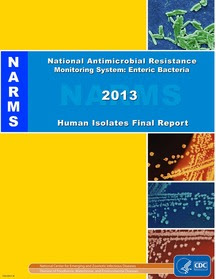
Antibiotic Resistance in Foodborne Germs is an Ongoing Threat

The news about trends in antibiotic resistance in foodborne germs is mixed. According to human illness data posted online today by CDC, the ongoing public health threat of antibiotic resistance in foodborne germs continued to show both positive and challenging trends in 2013. The National Antimicrobial Resistance Monitoring System (NARMS) tracks changes in the antibiotic resistance of six types of common foodborne germs found in sick people, retail meats, and food animals.
The good news from the 2013 NARMS Annual Human Isolates Report is that multidrug resistance (resistance to three or more classes of antibiotics) in Salmonella has not increased, remaining at 10% of infections. However, resistance in some types of Salmonella is increasing. For example, multidrug resistance in a common Salmonellaserotype called I4,[5],12:i:- was 46%, more than double the rate from two years before. Campylobacter, another germ that is transmitted by food, showed one in four samples from sick people are still resistant to quinolones like ciprofloxacin.
|
In 2013, NARMS tested more than 5,000 germs from ill people for antibiotic resistance.
 |
Most Salmonella and Campylobacter infections cause diarrheal illness that resolves within a week without antibiotics. However, these germs can also cause infection of the bloodstream and other sites. When germs are resistant, antibiotics may be ineffective, increasing the chance of a severe illness.
NARMS is a collaboration among state and local public health departments, CDC, the U.S. Food and Drug Administration (FDA), and the U.S. Department of Agriculture (USDA). NARMS helps protect public health by providing information about bacterial resistance, the ways in which resistance is spread, and how resistant infections differ from susceptible infections. Understanding frequency and trends in antibiotic resistance helps doctors to prescribe effective treatment and public health officials to investigate outbreaks faster.
|
The FY 2016 President’s Budget requests additional funding for CDC to improve early detection and tracking of drug-resistant Salmonella and other urgent antibiotic resistance threats. The proposed initiative would allow CDC to check nearly every Salmonella sample and many more Campylobacter samples for resistance more quickly.

Learn More
- National Antimicrobial Resistance Monitoring System for Enteric Bacteria (NARMS)
- Frequently Asked Questions About Antibiotic Resistance and Food Safety
- Antibiotic Resistance Threats in the United States, 2013
- Antibiotic Resistance Solutions Initiative
- National Action Plan for Combating Antibiotic Resistant Bacteria






















.png)











No hay comentarios:
Publicar un comentario